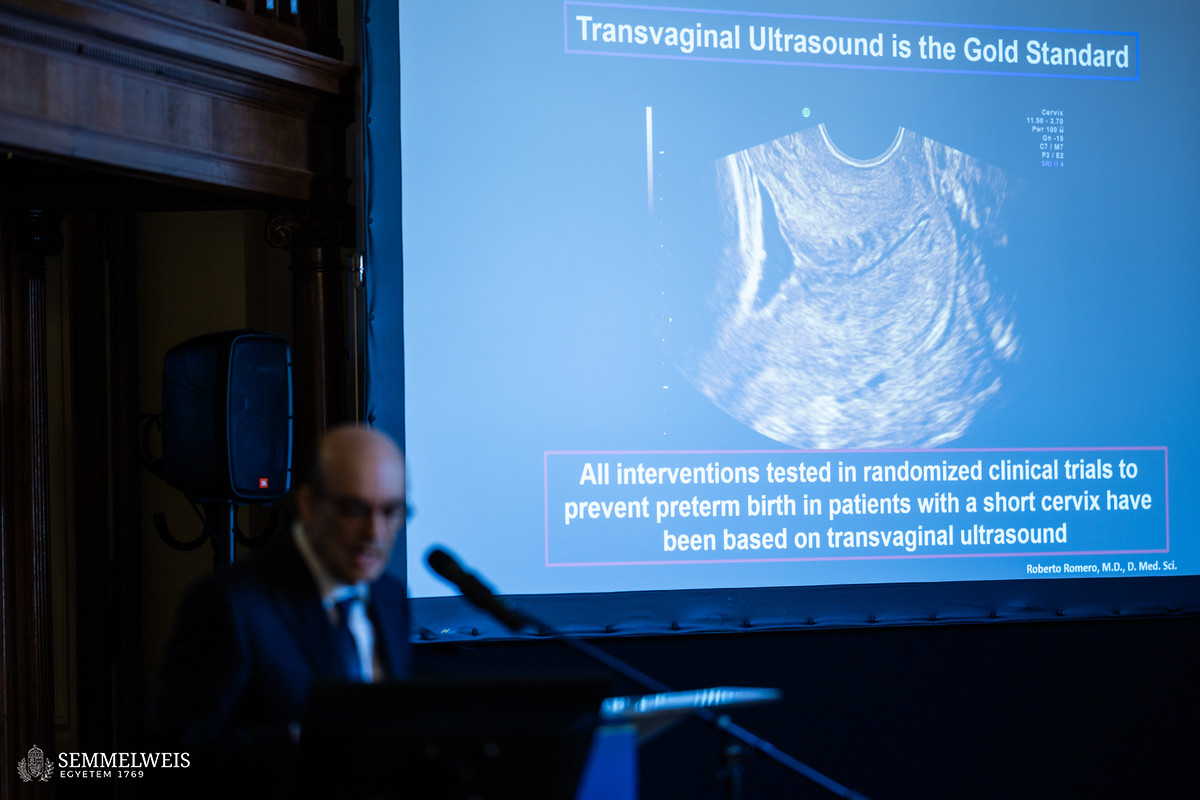At the opening ceremony of the event, held on September 20 in the Semmelweis Salon, Vice-Rector for General Affairs Dr. Ferenc Bánhidy welcomed Dr. Roberto Romero, Chief of the Pregnancy/Perinatology Research Branch of the National Institutes of Health, Editor-in-Chief of the American Journal of Obstetrics & Gynecology, and Doctor Honoris Causa of Semmelweis University. Dr. Ferenc Bánhidy drew parallels between the work of Dr. Roberto Romero and Ignác Semmelweis: While in Semmelweis’s time, puerperal fever was one of the most pressing problems in obstetrics, today premature birth is the leading cause of perinatal morbidity and mortality worldwide, and Dr. Roberto Romero is one of the pioneers in this field, he stressed. Afterwards, the host of the event, Dr. Nándor Ács, Director of the Department of Obstetrics and Gynecology and President of the Hungarian Society of Obstetrics and Gynaecology, spoke about Dr. Roberto Romero’s professional achievements and awards, mentioning that there were well-known Hungarian specialists in the field of obstetrics, gynecology, and fetal medicine who worked under the guidance of Dr. Roberto Romero.
 In his talk, Dr. Roberto Romero highlighted preterm birth as one of the most significant challenges in modern obstetrics, with approximately 15 million preterm births annually. He explained that preterm labor could be spontaneous or medically induced due to conditions like pre-eclampsia or fetal growth restriction. He emphasized the importance of measuring cervical length as a predictor of preterm birth, as shorter cervices increased the risk. Dr. Roberto Romero discussed the role of progesterone in preventing preterm birth and concluded that administering vaginal progesterone could significantly reduce the rate of early preterm deliveries and improve neonatal outcomes. As for the use of pessaries in preventing preterm birth, he pointed out that, despite initial promise, multiple randomized trials, including a study from the United States, had found no evidence of efficacy. He argued that progesterone should be widely used as an integral part of health policy in every country:
In his talk, Dr. Roberto Romero highlighted preterm birth as one of the most significant challenges in modern obstetrics, with approximately 15 million preterm births annually. He explained that preterm labor could be spontaneous or medically induced due to conditions like pre-eclampsia or fetal growth restriction. He emphasized the importance of measuring cervical length as a predictor of preterm birth, as shorter cervices increased the risk. Dr. Roberto Romero discussed the role of progesterone in preventing preterm birth and concluded that administering vaginal progesterone could significantly reduce the rate of early preterm deliveries and improve neonatal outcomes. As for the use of pessaries in preventing preterm birth, he pointed out that, despite initial promise, multiple randomized trials, including a study from the United States, had found no evidence of efficacy. He argued that progesterone should be widely used as an integral part of health policy in every country:
To me, the issue is simple. It’s a big problem. We have a way to identify the patient at risk. We have treatment. It’s cost-effective. We don’t know of any reason to be concerned about harm. But I’m cautious about this because we never know the long-term effect of anything. So, progesterone should not be given to everybody, it should be given to the patients who benefit. – Dr. Roberto Romero
As for the selection of patients eligible for progesterone treatment, he added that it should be reserved for those with a short cervix and a history of preterm birth. Following his talk, Dr. Roberto Romero answered questions from the audience, pointing out that although there were other forms of progesterone treatment (oral and intramuscular, i.e. injected into the muscle), vaginal administration was the most effective and safest option, as he and his colleagues had demonstrated. For some patients, individualized care is recommended, such as the combined use of progesterone and cervical cerclage, he added.
Some form of threatened miscarriage or threatened preterm labor affects 10-20 percent of pregnancies. A study published by Professor Romero in 2018 proved that vaginal administration of progesterone reduces the risk of preterm birth and miscarriage. This method has been used in Hungary, including at Semmelweis University, basically since the discovery, so if someone comes to the department with symptoms of threatened miscarriage or preterm birth, they are treated with vaginal progesterone, said Dr. Nándor Ács, Director of the Department of Obstetrics and Gynecology.
Dr. Balázs Csizmadia, Eszter Keresztes
Photos by Bálint Barta – Semmelweis University












